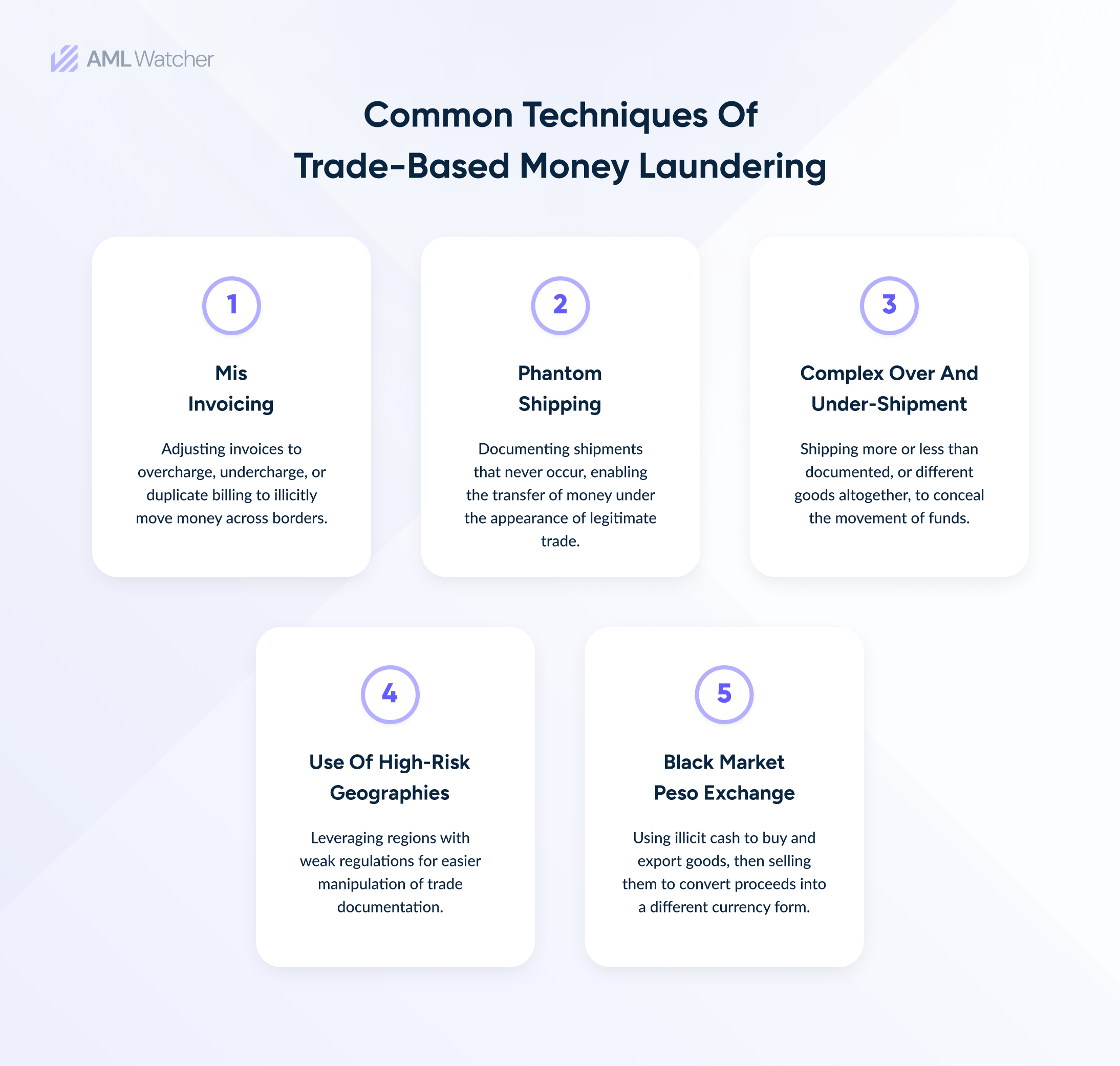
Top Red Flags of Trade-Based Money Laundering
In 2023, Global Financial Integrity proposed a global survey on trade-based money laundering highlighting that “it undermines global development and presents difficult challenges for law enforcement. Even though different estimates place Trade-based money laundering activity in the hundreds of billions or trillions of dollars yearly, the report states that only US $60 billion in money laundering was found in court cases spanning from 2011 to 2021, that are related to TBML.” The study also highlighted common TBML schemes, such as product mis-invoicing, which accounted for 63% of the cases from nations like Mexico, Colombia, the United States, China, and Hong Kong.
Trade-Based Money Laundering represents the most intricate and sophisticated way of money laundering by criminals from the activities that are carried out in other countries.
As per UNODC estimates, international money laundering amounts to $800 million to $2 trillion yearly, with TBML accounting for 87% of the total share of all illicit financial flows worldwide. Governments, financial institutions, regulatory organizations, and other businesses are facing a great demand to counter this issue.
It might be difficult to identify and stop TBML because it can happen in both legal and illegal financial activities. Criminals may utilize terrorist financing, money laundering, tax evasion, smuggling, drug trafficking, and corruption as ways to launder their illicit gains. They can trick authorities and conceal illegal funds by shipping documents, falsifying trade invoices, and over-invoiced financial transactions to build an intricate web of operations.
Seems interesting! Do you want to learn more about TBML?
Continue reading this blog because we’ll discuss what is trade-based money laundering, its common red flags, and the most reliable approaches to counter trade-based money laundering in any financial unit.
What Is The Concept Of Trade-Based Money Laundering?
According to the FATF, “TBML is the act of hiding and transferring funds through various trade modes to give legitimacy to the illegal sources of the proceeds of crime.”
TBML is a technique utilized by fraudsters to take advantage of the difficulties involved in international trade transactions to transfer illicit finance across borders. Criminals use trade manipulation to hide the source of their money and give the impression that it is legal. Then they incorporate “dirty money” into the established financial frameworks.
So we can say that Trade-based money laundering is a deadly issue for the international economy as it may ruin the whole financial system in the future. Governmental institutions, bankers, and regulators are in charge of strict monitoring of money laundering transactions evading TBML to protect the integrity of trade worldwide. This entails enhanced transparency of international trade, strengthening anti-money-laundering regulations worldwide, and better cross-border trade cooperation.
Common Trade-Based Money Laundering Examples
Some practical instances of TBML schemes that must raise trade-based money laundering red flags include:
-
Documentary Letter of Credit Irregularity
A Clearing bank finds irregularities and papers missing in a documentary letter of credit sent internationally. Consequently, the transaction is denied, and the documents are sent back.
-
Shell Corporations & Illicit Trade
Shell corporations would buy electronics using their illegal gains and then sell to buyers in high-risk countries without due diligence. The banks check these companies’ areas of registration are different; they all get listed on the bank’s watch list for monitoring purposes.
-
Fraudulent Medical Supply Transactions
A multi-million dollar letter of credit for medical supplies makes use of mismatched invoices between the initial and final recipients, with overcharged substitute invoices. The bank suspects any link between the first recipient and the health bureau’s agent, stops the transaction, and places them on their internal blacklist.
We’ve captured the basic idea of trade-based money laundering with key examples. Now let’s move forward and find out the common trade-based money laundering red flags.
What Are Critical Red Flags Of Trade-Based Money Laundering?
The United States Department of the Treasury indicates that “Processing trade can be a lengthy and complicated task, especially with the global nature of supply chains, connecting companies worldwide that all affect and influence one another.”
To counter trade-based money laundering, companies should powerfully resort to promoting enhanced AML and KYC controls and prioritize identifying AML red flags in trade financing and correspondent banking. Many businesses are unable to make their programs AML-friendly due to built-in layers of different industrial architecture.
TBML Red Flags
Enterprises can have a higher chance of identifying TBML if they are skilled with or familiar with the intensity of threats. In light of this context, the Financial Action Task Force created a list of TBML Red flags or risk indicators pertinent to the public and private sectors in 2021. These red flags consist of:
Structural Risk Indicators
- Complicated structures or unusual business operations, like the fact of using shell companies or firms positioned in high-risk jurisdictions.
- Entities that are registered at large amounts of addresses without a specific unit reference, for example, industrial complexes or high-density residential or commercial buildings.
- Using platforms that do not match the business they are reporting on and other such ambiguities.
- Companies that do not have an online presence or that have a website that covers the company’s business don’t look legitimate.
- The corporation and its trade operations are covered in negative news coverage.
- Trading companies that use names that are similar to those of more well-known rivals appear associated with them.
Trading Risk Indicators
- Trading action that is not connected to their state line of business, for example, car dealers trading heavy metals such as gold and platinum or textile material.
- Trade deals that are beyond usual will include deals that have such third-party intermediaries or that are using such complex trade routes.
- Traders make trading instruments that are an excessive mix of various products, merge all the products in one place, or use one product for a longer period.
- Exchanging companies, individuals, or corporations that fail to cover their operating costs for the long term or who overspend on items that do not suit their budget.
- Small trading associations are certainly in focus when they import or export large quantities or appear in the top high-value trading partners’ lists.
Document Risk Indicators
- Inconsistencies or disagreements on trade certificates, contracts, and invoices.
- A trade deal adjustment that might not realistically reflect market values or similar transaction adjustments.
- Trade paperwork that only makes occasional or ambiguous mention of the goods being shipped.
- The goods shipped out with fake transfer notes or falsified documents.
- Simplistic trade documents that do not reflect the complexity of the dynamics anticipated in the market they support.
- Shipments that route through many different jurisdictions, administrative subdivisions, or regions and from zero to no economic relevance.
Account And Transaction Monitoring Risk Indicators
- Trading companies that change payment conditions specifically for an importer or an exporter at the last minute.
- Accounts with many transactions that differ materialistically from the activity they claim to pursue.
- Accounts that have a greater number of transactions or deposits that are being instantly converted into other accounts and the businesses’ incomes at the end of the day are low or the business motive is not clear.
- Particulars related to goods that are not paid by the account holder like payments for imports.
- Regular small sums of cash deposits fall slightly below the reporting line limits.
Approaches To Manage And Monitor The Risk Involving TBML
Entities with exposure to TBML should consider the following measures to address the potential risks:
- Developing the risk-based assessment procedure to determine the vulnerabilities of TBML, taking the sector and region of operation into account would be a rational practice.
- Adopt stringent measures such as customer due diligence processes with consideration to beneficial or controlling ownership to defend against complex structures that could be an expression of TBML.
- Filtering customers and third parties as well by running due diligence checks on the regulatory databases as well as assessing the counterparty for reputation risk.
- Conducting an organization-wide training of all employees on how to recognize and stop TBML trade-based money laundering transactions. The training should focus on the signs and peculiarities that are specific to the TBML issue.
Are you searching for a trustworthy and efficient organization, which will help you to detect, evaluate, and mitigate trade-based money laundering risk?
Rest Assured! Because AML Watcher is the perfect answer to your search.
How Does AML Watcher Help To Reduce TBML?
Apart from this fear of the maximum risks of money laundering, AML Watcher is one prominent player engaged in offering reliable and effective sanction screening solutions to reduce the rates of money laundering and financial crimes. Use our advanced AML compliance-centric risk screening database that is developed exclusively for quick risk assessment.
Our AML solutions have been developed and designed to help financial institutions, businesses, and all other kinds of organizations detect and counter money laundering and other financial offenses such as trade-based money laundering. It contains:
Risk Scoring: The software adapts to the danger of this kind of money laundering by assigning risk scoring to those fund transfers that are more likely to be involved in terrorist financing. This helps businesses to prioritize their digital assets at the highest point of their risk, where transactions are made.
Real-Time Monitoring: The software automatically processes sanctioned data and detects abnormalities, for example, a profile with unusually large amounts of money flow, profiles from countries that have a reputation of being involved in criminal activity, or organizations that have been connected with crime in the past.
Reduced False Positives: We are driven to lower FinCrime with our innovative screening technology and protect the sector with minimum false positives. Redesign your risk assessment with cutting-edge standards that offer the global clientele efficiency and accuracy.
Enhanced Due Diligence: It can perform more robust due diligence on customers and vendors screening against global sanction lists, watching, and all other databases. It may be taken as a tool to enable firms to be aware of the risks arising from TBML before it becomes a serious problem.
Alert Generation: The software has the function of giving quick alerts for suspicious transactions so that businesses can put an end to TBML Red flags before they even start.
To conclude, Trade-based money laundering presents various threats to smooth international trade, financial stability, reliable business dealings, and efficient compliance efforts. Firms need to understand the basic principles of TBML, its red flags, and preventive solutions to reduce the chances of financial crimes. Global regulators, government authorities, and financial companies must detect, analyze, and stop trade-based money laundering by implementing the latest AML technologies that will boost international cooperation and create a strong world economy.
Since trade-based money laundering red flags and trade fraud schemes are transnational and multilateral, compliance managers must evaluate the chances of danger with a comprehensive risk analysis to analyze whether these schemes can damage global business operations.
At AML Watcher, our sanction screening solutions utilize artificial intelligence and advanced algorithms as a basis for the screening and highlighting of financial events and patterns that are usually associated with trade-based money laundering.
We provide services that set us apart from competitors in our industry by utilizing the most recent advancements in phonetics and fuzzy matching technologies to satisfy the demands of quickly and accurately screening data. In such a way we display our screening solution that can derive the required context of adverse media from thousands of sources. Therefore, there would be zero information loss for the end recipient.
Leverage our 60,000 plus Watchlists, Sanctionlist, PEP lists databases, and international leaks sources to screen profiles from any corner of the globe to check the true nature of their business operations which may be related to international trade or any shell-corporation activities.
Feel free to contact our staff any time if you want detailed information about our AML screening solution which will help your business to stay safe from any trade fines.
We are here to consult you
Switch to AML Watcher today and reduce your current AML cost by 50% - no questions asked.
- Find right product and pricing for your business
- Get your current solution provider audit & minimise your changeover risk
- Gain expert insights with quick response time to your queries






